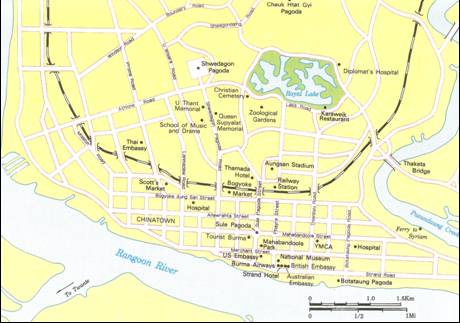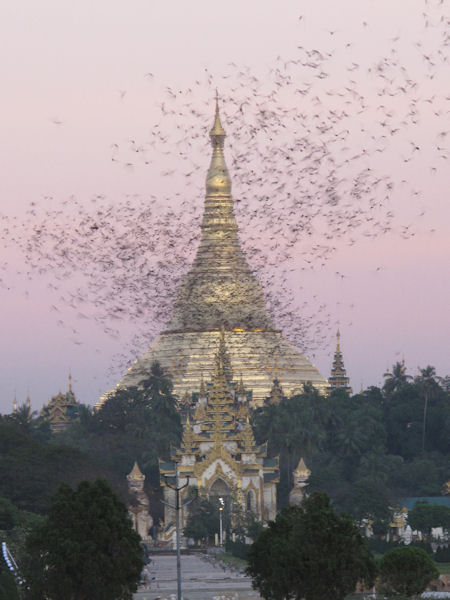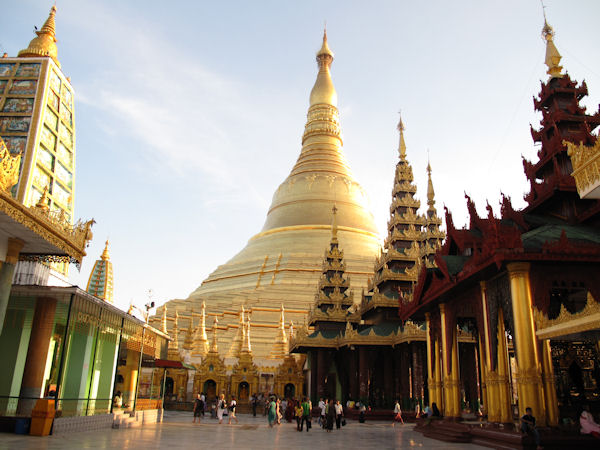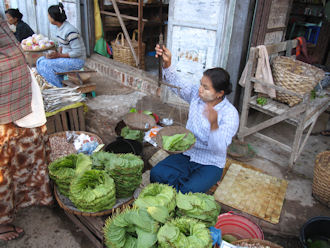

3. In Yangon – the largest city in Myanmar

3.1 General
Yangon, formerly known as Rangoon, is the largest city in Myanmar, and was built in 1885. It covers over 350sq km, and has a population of over 5 million. It is located in the southern part of the country and in the Ayeyarwady river delta. Yangon is the former capital of Burma. In 2006, the military government officially relocated the capital to Pyinmana in central Myanmar. It is still the transportation hub of the country and its commercial and industrial centre.
Yangon is a combination of two words yan and koun, which mean “enemies” and “run out of” respectively. It is also translated as “End of Strife”.
Yangon had been a cosmopolitan city with a mixture of people including Portuguese, Dutch, English and Chinese since the 17th century. But it is now a predominantly Bamar (the local ethnic group) city with a large Indian minority and a growing Chinese population.
We arrived at Yangon in the evening of 9th Jan and made it as our base for our tour in Myanmar. From here we flew to Bagan on 12th Jan and returned in the evening of 15th Jan. We returned home from here in the evening of 16th Jan.
During our short stay in Yangon, we visited the most sacred Buddhist site in Myanmar; Shwedagon Pagoda and its busy markets.
3.2 Shewdagon Pagoda
Shwedagon Pagoda is Yangon’s most remarkable architectural achievement and also the most sacred of all Buddhist sites of Myanmar. It dominates the Yangon skyline. The golden stupa is over 300ft tall and the whole complex covers an area of 14 acres. Around the stupa there is a great variety of statues, temples, shrines, images and pavilions.
According to legend, the original stupa was built by the Mon people sometime between the 6th and the tenth centuries. Since then it has been rebuilt several times and its current form dates back to 1769. Also according to legend, two merchant brothers met the Buddha who gave them eight strands of hair to take back to be enshrined in Burma. The two brothers and their king, with the help of a number of spirits, also discovered the hill where relics of the previous Buddha had been enshrined. Once the relics were safely enshrined, a golden slab was laid on their chamber and a golden stupa was built on it. Still according to legend, in subsequent times the stupa fell into disuse which was subsequently repaired by Emperor Asoka. In the 15th century, the tradition of gilding the stupa began. In the following centuries the stupa suffered a number of earthquakes and was also raided several times.
From the base to the top of the pagoda, the surface is now gilded with pure gold leaves. About every ten years it is re-gilded with over 13,000 pure gold plates each a foot square (approximately 60 tons).

Sunset at Shewedagon Pagoda with hundreds of bats swarming over the stupa.

Around the main stupa, there are many other smaller statues, temples, shrines & images.




3.3 Streets & Markets in Chinatown
The Chinatown of Yangon is located in the centre of downtown. The roads to the Chinatown were steaming with traffic. The area is the busiest quarters of the city.
In Chinatown, the Chinese community built their residences, clan associations, temples, offices and shops.
There were a variety of restaurants, gold and jewelry stores, clothing shops and mini-markets displaying their wares while roadside food stalls dispense steaming dishes and snacks. Fruit vendors offered fruits in season which included all kinds of bananas, papayas, pomelos etc.
Most of the Chinese in Yangon live in this part of the city which forms a town of its own. Businese is booming in this area and it has become a tourist attraction. There is also a Cantonese Guan Yin Temple and a Hokkien Keng Hock Kong in the Chinatown. Major Chinese festivals and religious celebrations are held in the temples.
 |
 |
Roads to Chinatown were congested
 |
 |
Very rural setting in the markets

Farewell Lunch in our Guide’s Apartment in Yangon
Back to Pg 1 / Pg 2 / Go to Pg 3